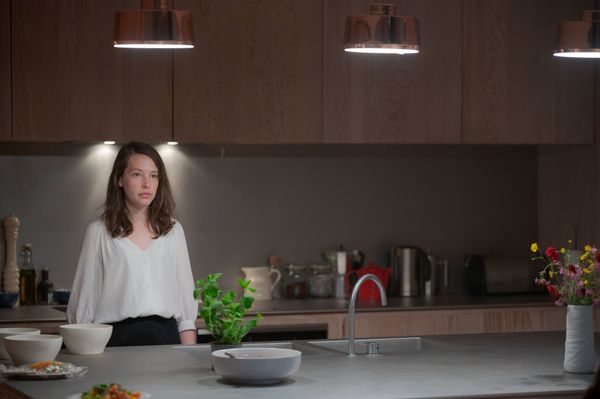 |
| Annes Elwy in The Feast |
Welsh language films which enjoy international success are rare beasts, genre ones even more so, so it’s no surprise that the festival success of The Feast has got people talking. There’s a lot to admire in this finely crafted film, which we first caught when it screened at last year’s Beyondfest. It tells the story of a dinner party held in celebration of an environmentally dubious deal which is waited on by a young woman who is not what she appears. Themes around class, capitalism and the relationship between people and land collide with ancient tradition and otherworldly cruelty.
Playing that unusual young woman, Cadi, is Annes Elwy, and she and director Lee Haven Jones joined me for a chat ahead of the film finally making it into UK cinemas. Lee began by telling me how the film, which was scripted by Roger Williams, came about.
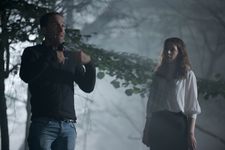 |
| Lee Haven Jones and Annes Elwy on set |
“I have worked with Roger a number of times on television projects and I always wanted to make a film really,” he says. “And it was out of out of that relationship that The Feast came about. It was a result of both of our passion for horror films, on the one hand, and then our passion for Wales and wanting to tell stories about Wales, on the other hand, and yeah, I just wanted to say something about the country in which we live, and in the language in which we conduct most of our lives.”
“Lee approached me at a BAFTA Cymru event, and just told me that he had a horror script he wanted me to look at,” says Annes. “I was a little bit hesitant, maybe. I obviously had wanted to work with Lee, but on a horror film, I wasn't so sure. But he sent me the script. When it came through, I read it and it kind of blew my mind. It was so unexpected and not what I had foreseen at all. In the whole script, and the role of Cadi, things were changing all the time, and these situations that were so bizarre, all these things Roger had written that I would never have imagined. And also for Cadi, to have this character that’s in it throughout, but barely says a word, I just thought she was such an enigma. Instantly, before I'd really figured out what sort of character she was, I definitely want to play her because I knew it would be fun to find out who she was and how she would appear. I agreed very quickly.”
I ask about the financial challenges of choosing to make the film in Welsh, and Lee explains that it was supported by Ffilm Cymru Wales, the BFI and others.
“It was relatively straightforward, and the whole process was really seamless. I know that's not always the case with film. For us the difficulty came when we finally finished the film, and then we had our sales agent and our distributor, both here and in the States. And then Covid struck so that the decision was taken to not sell it to a streamer, but to wait and have a festival run, and build an audience for it that way. I love cinema and I always wanted to do that with my first film so I was very happy to acquiesce with that decision.”
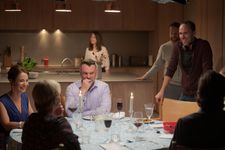 |
| Preparing to shoot dinner |
There are a lot of things going on in the film but it is folk horror at a certain level. Obviously there are films like that from all over the world, but it's often seen as quite an English genre. How did he manage to put that distinctive Welshness into it?
“What I what I kind of realised while I was discussing this idea with Roger was that actually, the kind of horrors I was watching as a child, you know, the slashes and commercial horror, that was all American, and then you have the folk horror genre that is quintessentially English. But what I see with a lot of our literature from centuries ago, specifically the Mabinogion, is that it was inherently horrific. Awful things happen in a lot of our literature. One day I said to Roger, ‘You know, I think we should reclaim the horror genre for Wales.’ So that was where we started the process.
“Because we don't have that much cinema in the Welsh language. I saw this as an opportunity to define a singularly Welsh sort of cinematic aesthetic, in a way. So I looked beyond the border. A lot of my influences come from the cinematic culture of Japan and Korea, for example. There's definitely a lot of influences from Europe. But I wanted to do something that was distinctly un-English, actually. Because I think a lot of the time in my television work, you know, the reason why it doesn't travel in the Welsh language, the reason why it has to be remade in the English language, is because tonally and culturally and stylistically and aesthetically it feels very English. So that was the decision really, to try and define a Welsh cinematic aesthetic.”
It's certainly a very distinctive film, I say. And something that I like about the folk horror aspect of it is that often we look at folklore, there's a temptation to romanticise and to make characters much more sympathetic, but The Feast retains the cruelty found in the old stories.
“Absolutely. You know, in relation to Cadi, I've been speaking about the indiscriminate forces of nature. I really wanted to keep to keep that in the character. I think it's interesting, you talk about the romanticisation of the folkiness of it, and I think about the way that the Welsh landscape, and even the Welsh language have been portrayed over the years, you know, it's very folksy, it's very romantic, and yeah, we wanted to kind of subvert that cliché. And actually, that's been one of the journeys of this film, for me to subvert the cliché of what a Welsh film should look like. It's not particularly romantic, and it doesn't really matter. It's raw and it's visceral.”
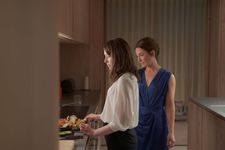 |
| Cadi prepares dinner |
Much of that difference comes through in Cadi herself.
“Yeah, definitely, she is a little creature of the soil,” says Annes. “I think her instincts are either childlike or animalistic. She doesn't behave in the stereotypical human ways, and so playing her was a very different experience to playing any other part I’ve played. But it was a really fun process, to find how she existed in this world, and there was something that was just so relaxing about this, engaging with human behaviour and solely connecting with the feel of things and smell of things. And those things were very natural for her.
“In the scene where she's just laying in the earth, and the ivy surrounds her, that's where she's at home. And she's completely out of her element walking around the town. But she knows that that's just what she does for now, and she finds her way through it, and she takes it all in. So playing her was just a real treat, really. Every actor aims to be able to be fully present and fully relaxed, but with Cadi it was possible, because I didn't have many lines to remember. All I had to do was absorb the surroundings.”
She seems very vulnerable early on, and then she gradually comes to seem a lot more powerful, and part of that is the way that she’s shot but it’s also in that portrayal. I ask Annes how she approached that journey.
“I think that's really connecting to how Cadi would have experienced that,” she says. “You know, walking up to this huge, brutal, strange house in the middle of the Welsh countryside puts you on edge. Seeing this family that seem so confident and have these expectations straightaway of how I should be doing things, it really puts you on the back foot. But as soon as she's made sense of the people and settled into the space, then she can just reconnect with her power that I think she would get from nature, mainly, but also just the things that she can hold on to, the texture of things, she gets a strength from these things. And so with that, she can grow and really change as a character. And again, that was another gift of the role, that we do have this dream journey that Cadi goes on.”
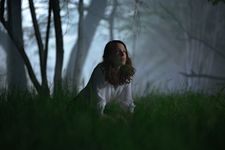 |
| "She is a little creature of the soil" - Annes Elwy on Cadi |
I ask Lee about the way that he shot Cadi during that process, with an increasing focus on her physical prowess, and how he seemed to be reversing the standard cinematic approach to gender, as he also uses shots which objectify one of the male characters.
“Absolutely,” he says. “I am obsessed, I think, with with the psychology of the frame: how we view a character, what we infer from where that character sits within the frame. Is the camera looking up at them, or looking down? Or whatever. And that was definitely part of the visual grammar that we were applying in this. Again, you mentioned the way that gender is depicted in films often. For me, this is very much a piece about the two female characters, the two female presences in a way, more than it’s about the males. It is interesting just to swap that against what is expected of a film. And that was very definitely my intention.
“Going back to what you're saying about framing and the way that we see Cadi, I think often within horror film, actually, the default is to shoot everything handheld, which gives a sense of urgency and excitement, and I wanted to do the opposite of that, which is sort of do something a bit more forensic, a bit more objective. Clinical rather than that sort of slightly forced handheld.”
Some of that clinical effect comes down to the location. How did they find that, and how did he work out how to use that space?
“Roger and I have done a short film set in a similar kind of location, and as I mentioned, we wanted to subvert the cliché of a Welsh horror. So we knew it had to be a modern house. So what I did initially, in the absence of a location manager, very early on, I just googled contemporary design houses in Wales. I found about eight or nine, and this was the second one that I saw. And I just fell in love with the architecture. It’s designed by an architect called John Pawson, an English architect. And I just thought that it would be a great metaphor for the family, this brutal, hermetically sealed box in the countryside, so I went to visit the place. I took Roger along with me.
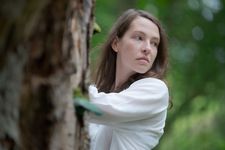 |
| "We do have this dream journey that Cadi goes on" - Annes Elwy |
“What we did was, we decided to incorporate elements of the architecture within within the script. So for example, the cell was something that existed within the house. The moment I saw that I was like, ‘We must absolutely write this into our screenplay,’ so we did that. I love that way of working with what you find, rather than kind of having to build it or whatever.”
The cinematography is beautiful throughout, but some of the shots look a lot like classical paintings in the way that they're framed, particularly where the food is concerned. Was that an influence for them?
“I guess it was. As I said earlier, I'm fascinated by the psychology of the frame. For me, framing and composition is one of those elements that I have worked at, because I don't know whether you know, but my background is in acting, and I came to directing via acting. Somebody said to me once, a director needs three things. One is an understanding of the actor’s process, which of course I have. The second thing is the desire to say something, which I've never been short of, even as a child. And the third thing was an understanding of aesthetics, kind of in an art history sense, actually. So that is one of the elements that I've been working on. I should mention Bjørn Bratberg, who was the DoP – he and I have worked together on a number of occasions. I guess it's a visual grammar that we've been working out for quite some time, really, and that’s the fruits of our of our labour there.”
I tell him that I’m interested in the costuming as well, and the very artificial look which it gave to the owners of the house, in contrast with Cadi.
“Yeah, absolutely,” he says. “I mean, it's all part of the look of things, and we had a great costume design on it called Dawn Thomas, who completely understood the context. You mentioned that contrast – I think about it as colliding two different worlds together, or two different characters together, or two different energies. That was very much intended.”
The other thing that I think is brave about the film is the pacing, because certainly with horror these days, a lot of things get faster and faster, and it's quite a difficult thing to pull off a slow burn film like this.
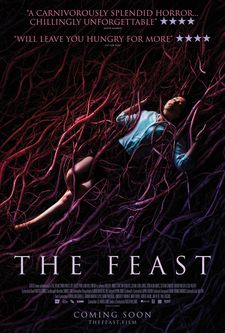 |
| The Feast poster |
“Yeah, I mean, there was no other way to tell this story, in my mind, and also, I'm a massive slow cinema fan. It’s diametrically opposed to what I'm used to doing as a television director, which is keeping the pace of the storytelling quite soft. I guess I pushed against that a bit too far, maybe. I don't know. But I'm interested in watching action unfold over an extended period of time. So we do have lots of long takes and long shots.
“There's a dinner party scene in The Feast that is about five or six minutes, and I think we have four shots in it, and mainly plays out on two wides. And that's something I've longed to do in my television work, but unfortunately, I've never quite been allowed to do it. Executive producers always, always talk about the importance of the close-up, but of course, a close-up only has power if it's used sparingly.”
He could talk about this all day, he says, with an apologetic laugh. Unfortunately we have limited time, so I move on to ask Annes how she felt, as someone not accustomed to horror, about what was required of her for some of the film’s more grotesque scenes.
“Bizarrely, somehow, it didn't really feel like I was doing horror,” she says, “even though the things I was doing were sometimes pretty grotesque. Specifically, the licking of the leg with maggots really was pretty unusual. But also, so much time that Cadi experiences in the film is so gentle that the horror elements only really come in moments really. Even with the father, you're singing, gently sitting down as if you're cradling a baby, and so that experience of horror, to her, wasn't very horrific. She only let herself feel the horror of things right in the very end, when it was all done, really.”
I suggest that maybe there’s a different kind of horror for her because she's horrified by what's happening to the land.
“Exactly,” says Annes.. That's her motivation. I think that's more how she's experiencing it. The idea of hearing people talk about happily mining the land, that is, of course, a painful, painful thing for her to hear. And so you're right, the horror for her is in that, not in the grotesque stuff, but for me playing the part, the grotesque stuff – that was just bizarre.”
Finally, I ask each of them how they feel about the way the film has been received at festivals.
“It seems to have done really well,” says Annes. “It's just really nice that it's getting its release. We filmed this so many years ago now and we had such a good time doing it, and I loved the script so much, and loved the whole process of building Cadi and paying her and collectively making this film, that it's just really nice that not only people getting to see it finally, but that they seem to be enjoying it. And sometimes they won't, and I totally understand that too, because it is a love or hate film. It's just really nice to share it with people.
“We'll see how how it's received back home, you know, across the UK and also in Wales, by people for whom watching a Welsh film won't be unusual. Well, you know, hearing a story in their own language is unusual, but it's not like the experience across the border, so it'll be interesting to see if it's received differently by Welsh speakers to the general public.”
“I'm delighted with the way that it's gone,” says Lee. “I have to say, I wouldn’t have thought, when we were making it in 2019, that we would have got to SXSW and various different festivals throughout the world, and won a few awards. And then we're having this massive release throughout the UK and Ireland, you know, yeah, it's amazing. And long, may it continue, you know? I'd love to think that this film might help to kickstart some kind of Welsh cinematic movement and pave the way for other films in the Welsh language.”
Will he be making them if that happens?
“Absolutely. We've got a few more horror films in us, I think. It'd be great to get a really strong Welsh horror brand going, because there's obviously an appetite out there and people have enjoyed it, and people have responded to it.”
The Feast opens in cinemas across the UK on Friday 19 August.





















